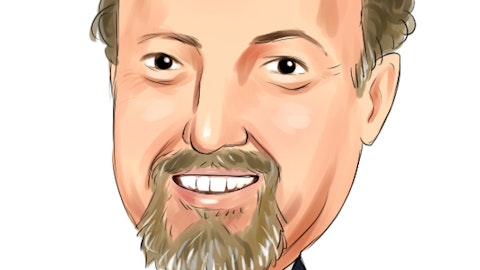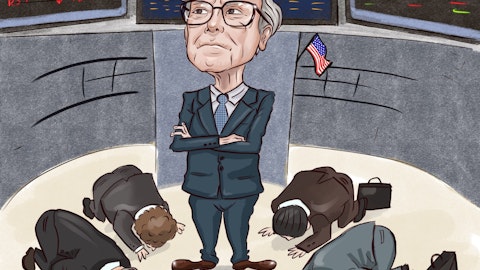The Procter & Gamble Company (NYSE:PG) Q2 2024 Earnings Call Transcript January 23, 2024
The Procter & Gamble Company beats earnings expectations. Reported EPS is $1.84, expectations were $1.7. The Procter & Gamble Company isn’t one of the 30 most popular stocks among hedge funds at the end of the third quarter (see the details here).
Operator: Good morning, and welcome to Procter & Gamble’s Quarter End Conference Call. Today’s event is being recorded for replay. This discussion will include a number of forward-looking statements. If you will refer to P&G’s most recent 10-K, 10-Q and 8-K reports, you will see a discussion of factors that could cause the company’s actual results to differ materially from these projections. As required by Regulation G, Procter & Gamble needs to make you aware that during the discussion, the company will make a number of references to non-GAAP and other financial measures. Procter & Gamble believes these measures provide investors with useful perspective on underlying business trends and has posted on its Investor Relations website, www.pginvestor.com, a full reconciliation of non-GAAP financial measures. Now, I will turn the call over to P&G’s Chief Financial Officer, Andre Schulten.
Andre Schulten: Good morning, everyone. Joining me on the call today are Jon Moeller, Chairman of the Board, President and Chief Executive Officer, and Jon Chevalier, Senior Vice-President, Investor Relations. I’ll start with an overview of results for the October to December quarter, Jon will add perspective on our recent results and strategic focus areas and capabilities. We’ll close with guidance for fiscal ’24, and then take your questions. October to December, was another strong quarter. Execution of our integrated strategy drove solid sales and market-share results and another quarter of strong margin progress, delivering strong earnings and cash results for the quarter. The strong results we’ve delivered in the first half of fiscal ’24, enable us to raise our outlook for core earnings per share and keep us on track to deliver within our fiscal year guidance ranges for organic sales growth, cash productivity and cash return to shareowners.
We continue to see the upper range on organic sales and core EPS as likely outcome for fiscal ’23 – ’24. So, moving to second quarter numbers, organic sales grew 4%, volume rounded down to a decline of one point as continued volume acceleration in North America and Europe focused markets was offset by softer shipments in Greater China, Eastern Europe and Middle East, Africa regions due to local issues in select markets. Pricing contributed four points to sales growth, consistent with the guidance we provided, mix was neutral to organic sales growth. Growth across categories continues to be broad based with eight of 10 product categories holding or growing organic sales this quarter. Home care, hair care and grooming grew sales high single digits.
Fabric care, family care, feminine care and oral care were up mid-single digits. Baby care was in line with prior year. Personal health care was down low singles against a very tough comp and a late developing cold and flu season this year. Skin and personal care was down mid singles due to SK-II in China. Growth was also broad based across geographies with North America, Europe, Asia Pacific focus markets and Latin America and Europe enterprise markets each growing organic sales. Focus markets grew 3% for the quarter and enterprise markets grew 7%. Organic sales in North America grew 5% with four points of volume growth. Over the last five quarters, volume growth in North America has been minus three, flat, then 2% growth plus 3% and now plus 4%, strong acceleration well ahead of the underlying market trends.
Europe focused markets were up 7% with three points of volume growth. As expected, both regions saw a step down in pricing contribution to sales growth as a large portion of price increases from last year have annualized. Importantly, volume accelerated in both regions to partially offset the pricing impact. Latin America delivered another very strong quarter with 17% organic sales growth, continued strong results in these regions. There are some targeted issues affecting other markets. Greater China organic sales were down minus 15% versus prior year. Underlying market growth was down mid to high single digits as consumer confidence weakened further. The SK-II brand in Greater China was down 34% due to soft market conditions and a temporary headwind for Japanese brands in the market.
Our consumer research indicates SK-II brand sentiment is improving and we expect to see sequential improvement in the back half. Underlying market trends have softened in some Europe enterprise and Asia Pacific, Middle East, Africa countries such as Egypt, Saudi Arabia and Turkey, following multiple rounds of pricing to offset inflation and due to heightened tensions in the Middle East. Global aggregate value share was up 40 basis points versus prior year with 28 of our top 50 category country combinations holding or growing share. In the U.S., all outlet value share was up 20 basis points versus prior year. U.S. volume share was up 50 basis points reflecting strong volume growth. Value share in European focus markets was up 90 basis points over the past three months.
In summary, North America, Europe focus Markets, Asia Pacific focus markets and Latin America, which combined represent three-quarters of company sales, delivered over 6% of organic sales growth in quarter two, with three points of volume growth and three points of price mix. These same markets grew 9% in quarter one with around two points of volume growth and seven points of price mix. Continued strong organic sales growth with accelerating volume growth to mitigate the anticipated annualization of pricing, consistent with our guidance. The balanced 25% of company sales including Greater China, Eastern Europe and Middle East Africa were impacted by local market issues we described. Quarter two organic sales for this group were down five points versus prior year.
We expect most of these effects in these regions to be temporary or annualizing, SK-II consumption is sequentially improving. We continue to expect China market growth to improve, and over time return to mid singles, and we expect market pressures in the Middle east and Turkey to ease over time. Moving to the bottom line, core earnings per share were $1.84, up 16% versus prior year. On a currency neutral basis, core EPS increased 18%. Core operating margin increased 400 basis points as 520 basis points of gross margin expansion were partially offset by increased marketing investments, wage and benefit inflation and foreign exchange impacts in SG&A. Currency neutral core operating margin increased 470 basis points. Productivity improvements were a very strong 340 basis points helped to the quarter.
Adjusted free cash flow productivity was 95%. We returned $3.3 billion of cash to share owners, approximately $2.3 billion in dividends and $1 billion in share repurchase. In summary, against what continues to be a challenging and volatile operating environment, strong overall progress in the first half of the year keeping us on track for our fiscal year guidance ranges. Now I’ll pass it over to Jon for his perspective.
Jon Moeller: Thanks Andre, and good morning, everyone. I’ll start by underscoring a few points Andre made in his discussion of the topline trends. Overall, continued strong top line progress 22nd consecutive quarter of 4% or better organic sales growth, volume acceleration in key markets, increases in aggregate market shares. This despite several notable headwinds, which should be temporary. Tensions in the Middle East will hopefully ease. Enterprise market volume impacts following price increases are usually temporary. While we can’t talk specifics of future pricing in any market, more stable foreign exchange and commodity costs will ideally reduce the need for additional large price increases. I spent six days in China with the team two weeks ago.
I met with consumers in their homes, with retail CEOs with our team, and with several government officials. In my view, the long-term China opportunity remains intact. The near term is likely to present some challenges. We’ll see what happens with the global cough cold season as a soft start to the season either reverses or eventually annualizes. No guarantee of immediate bounce back in any of these, but reason to believe they will improve over time. In addition to continued aggregate topline progress, a very strong bottom line, mid-teens core earnings per share growth two quarters in a row, while increasing investments in innovation, brand building and market growth. Our team continues to execute our strategy with excellence, enabling strong results over each of the past five years, pre COVID, during COVID and through a historic inflationary and pricing cycle.
I want to thank them both for what they delivered and for what they’re working to continue to accomplish. Our integrated strategy is unchanged. A focused portfolio of products and daily use categories where performance drives brand choice. The portfolio is performing, delivering broad based growth across nearly all categories and most geographies for several years. The announcements we made in December to change our go to market approach in Argentina and Nigeria will further sharpen our focus and strengthen our value creation potential. A good example of the dynamic nature of our strategy and our desire to aggressively allocate resources to where they create the most shareholder value. Next strategy element, ongoing commitment to an investment in irresistible superiority through innovation across the five vectors of product package, brand communication, retail execution and value holistically defined.
Leveraging that superiority to grow markets and our share in them to jointly create value with retail partners. The plans across the businesses are broader and stronger than at any time in the recent past as each team works to increase their margin of superiority and consumer delight. Superior innovations that are driven by deep consumer insights communicated to consumers with more effective and efficient marketing programs, executed in stores and online in conjunction with retailer strategies to grow categories and our brands, priced to deliver superior value across each price tier where we compete. Smooth tear Charmin Ultra Soft Smooth with scalloped edge perforations, a great example of consumer insights driving innovation to improve the in-use experience.

Consumer response to the new product has been overwhelmingly positive and is driving word of mouth recommendations in social media. Gillette’s superior propositions like the GilletteLabs razor with an exfoliating bar that removes dirt and debris before the blades, continue to drive growth in the global grooming category. GilletteLabs has reached shares greater than 20% in markets like Spain and France, and is building momentum in the U.S. and China. The global grooming category is on track for $1 billion of retail sales growth this fiscal year, with Gillette driving two-thirds of the increase, well ahead of our global share. Superior innovations like Dawn Power Wash and Dawn EZ-Squeeze in the U.S. and Fairy power spray and Fairy Max in Europe are disproportionately driving market growth in hand dishwashing with value share in the U.S. approaching 67%, merely 50% across Europe focused markets.
Third strategy element productivity, improvement in all of our operations to fund investments in innovation, brand building and market growth, to mitigate cost and currency challenges, and to expand margins and generate cash. We’re reaccelerating productivity back to pre-COVID levels with an objective for gross savings and cost of goods of up to $1.5 billion before tax. Visibility to more savings opportunity is increasing enabled by platform programs with global application across categories like supply chain 3.0. We’re working in a new way with retailers on the totality of the supply chain, end to end, versus simply trying to optimize each piece. One example using data and machine learning algorithms to optimize truck scheduling to minimize idle time for drivers.
We’re also using AI tools to optimize fill rates and for dynamic routing and sourcing optimization, $200 million to $300 million of savings opportunity across these areas. We have line of sight to savings from improved marketing productivity, more efficiency and greater effectiveness, avoiding excess frequency and reducing waste while increasing reach. We’re taking targeted steps to reduce overhead as we digitize more of our operations. The team has delivered strong cost savings in the first half of the year, and plans to build on this momentum. Next, constructive disruption of ourselves and our industry. A willingness to change, adapt and create new trends, technologies and capabilities that will shape the future of our industry and extend our competitive advantage.
We continue to be a constructive disruptor of brand building, in-housing more of the media planning and placement activity, using our proprietary tools and consumer data to increase effectiveness and efficiency of our communication. We’re disrupting traditional lab-based innovation models to dramatically increase the speed and breadth of discovery. Last but clearly not least, we’ve designed and continue to refine an empowered, agile and accountable organization model. Also, an increasingly diverse organization, enabling us to better serve an increasingly diverse set of consumers. So strong progress across all strategic pillars with significant opportunity ahead of us. No reason to stand still, as illustrated by the four focus areas we’ve outlined previously.
Supply chain 3.0 is delivering productivity as we just talked. We’re also driving improved capacity planning, greater supply agility, flexibility, data transparency, scale and resilience, all the way up and down the supply chain, inclusive of our retail partners. All of this was driving higher quality, increased supply assurance and higher on-shelf availability of our products, and of course better cash and cost structures. These programs improve superiority with consumers and further strengthen what is already the top ranked supply chain by our retail partners and third-party industry surveys. Environmental sustainability – superior propositions for consumers, customers and share owners that are sustainable, driving sales and profitability while reducing the footprint of our operations, enabling consumers to reduce their footprint and innovating to deliver cross industry solutions for some of our most pressing challenges.
A good example is the four chamber Ariel platinum PODS innovation that we launched in a new cardboard package. Extending our superiority advantage in product performance while improving sustainability by enabling great wash results even in cold water, already contributing to a two-degree celsius reduction in wash temperatures in Europe against a five-degree target. Also extending packaging superiority with a more attractive and more sustainable cardboard box. Digital acumen – leveraging data and digitization to delight consumers, streamline the supply chain, increase quality, drive productivity, all driving shareholder value. Fourth – the superior value equation for all employees, inclusive of all genders, races, ethnicities, sexual orientations, ages and abilities for all roles to ensure we continue to attract, retain and develop the best talent, and are best positioned to serve all consumers.
These four focus areas are not new and separate strategies. They simply strengthen our ability to execute the strategy. Our strategic choices on portfolio superiority, productivity, constructive disruption and organization reinforce and build on each other. We continue to believe that there is merit in doubling down on this integrated strategy, starting with a commitment to deliver irresistibly superior propositions to consumers and retail partners fueled by productivity. We remain as confident as ever in our strategy and our ability to drive market growth, and to deliver balanced growth and value creation to delight consumers, customers, employees, society and share owners. Now back to Andre for guidance.
Andre Schulten: Thanks Jon. As I mentioned, we expect the environment around us to continue to be volatile and challenging from input costs to currencies to consumer, retailer and geopolitical dynamics. However, our strong first half results enable us to raise or maintain key guidance metrics for the year. We’re maintaining our guidance range for organic sales growth of 4% to 5% for the fiscal year. This outlook includes a normalization in underlying market growth rates that we began to see in our second quarter results as the market lapsed the last waves of cost recovery pricing. For P&G, we expect the pricing contribution to topline growth to reduce by an additional 1 to 2 points in the back half of the year. We will continue to price for new innovations when warranted and to mitigate FX impacts.
On the bottom line enabled by very strong earnings growth in the first half of the year, we’re raising our outlook for fiscal ’24 core earnings per share from a range of 6% to 9% to a range of 8% to 9% growth versus last fiscal year. This guidance implies slower bottom-line growth in the second half. As we highlighted last quarter, the second half of the fiscal year will see less pricing benefit as we annualize more prior year increases. We will also see less commodity cost benefit in the second half. Wage and benefit inflation continues throughout the supply chain and in our direct costs, and FX headwinds will increase versus the first half of the fiscal year. As I mentioned, we continue to expect organic sales and core EPS growth toward the upper end of the renewed guidance ranges.
We estimate commodities will be a tailwind of around $800 million after tax in fiscal ’24 based on current spot prices. This is consistent with the outlook we provided last quarter. We continue to expect foreign exchange will be a headwind of approximately $1 billion after tax for the fiscal year. The vast majority of this impact is driven by Argentina, and is heavily skewed towards the back half of the year. This outlook is based on a forecast for continued significant devaluation of the Argentine Peso, which we expect to largely offset with appropriate price increases. We now expect higher net interest expense of approximately $100 million after tax versus prior year. General inflation and higher wage and benefit costs weakness are also earnings headwinds for the year.
We expect adjusted free cash flow productivity of 90%. We expect to pay more than $9 billion in dividends and to repurchase $5 billion to $6 billion in common stock, combined a plan to return $14 billion to $15 billion of cash to share owners this fiscal year. This outlook is based on current market growth rate estimates, commodity prices and foreign exchange rates. Significant additional currency weakness, commodity cost increases, geopolitical disruptions or major production stoppages are not anticipated within the guidance ranges. Finally, we’ll be closely watching the more volatile regions we mentioned earlier, including the health of the China market, and we’ll be keeping close watch on competitive dynamics to ensure P&G brands remain superior value for consumers and retailers.
Now, I’ll hand it back to Jon for closing thoughts.
Jon Moeller: We continue to be very pleased with the strong results P&G people are delivering in a challenging operating and competitive environment. Continued excellent execution of an integrated market constructive strategy. I want to thank each of them for that. While we expect volatile consumer and macrodynamics to continue, we remain confident that the best path forward is to double down on the strategy that has enabled strong results and remain committed to delivering balanced top and bottom-line growth and value creation for shareholders. With that, we’ll be happy to take your questions.
See also 20 Safest Countries for US Travelers in the World and 25 Best Kept Secret Places to Live in the US.
Q&A Session
Follow Procter & Gamble Co (NYSE:PG)
Follow Procter & Gamble Co (NYSE:PG)
Operator: [Operator Instructions] Our first question will come from Dara Mohsenian of Morgan Stanley. Please go ahead.
Dara Mohsenian: Hi, good morning, guys. So just wanted to focus on the back half. Clearly the 4% Q2 core sales growth result wasn’t as strong as the 7% Q1 delivery, which is very robust result. So obviously some quarterly volatility here. Can you just give us some perspective for the fiscal back half relative to Q2 in light of that first half volatility as you think through some of the key geographies and volume versus price mix, and some of the temporary impacts Jon mentioned? And then just same question on EPS basically, obviously very strong first half that continued in Q2, full year guidance implies a more muted second half. So, is there some conservatism baked in there? Help us understand that. I know Andre touched on it, but maybe give us a bit more detail there on the back half from an earnings perspective. Thanks.
Andre Schulten: Yes, morning Dara, let me start and Jon will add. On the top line, if you look at the first half, we are right in line with what we’re projecting for the year, an average of 5%, and we obviously then expect about 5% for the back half. We see volatility, as you had pointed out in some geographies that we mentioned in the script. I think the core point though is the core geography, 75% of the sales are performing very well. We continue to see acceleration in volume growth in North America with 4% volume growth, 5% sales growth. Europe is very strong. Latin America very strong. We continue to see volume acceleration in most places. So that gives us confidence that that projects well for the second half of the year.
We also expect some of the volatility that we experienced in quarter two to disappear or at least improve in the second half. The SK-II sentiment is improving based on our consumer research in China, and we are continuing to drive innovation, equity investment and really relying on our most loyal and passionate user base to help amplify that messaging, which is working well. So, we expect the effects to improve year-over-year – quarter over quarter. From an enterprise market standpoint, we also view the pricing impacts that are impacting some of the markets like Turkey to disappear over time, as pricing in the market is established, competitive pricing catches up and then the impact of the tensions in the Middle East certainly hopefully will improve as well.
So very strong continued performance on the core markets, which are 75% of the sales, and we expect somewhat improving trends and stabilization in the other 25%. On the EPS side, very strong performance in the front half, 17% in quarter one, 16% in quarter two, sets us up well for the upper end of their guidance range, which is reflected in the tightening of their guidance. However, to keep in mind, we see a reversal of a number of effects that have supported the half one results. We saw the majority of the commodity help flow through in the first half, and this is part of the improvement in quarter two EPS. We see the flow through happening faster than we would have anticipated in some instances, so that leaves less of a contribution for the second half.
We also have the majority of the foreign exchange hurt in the second half, about 75% of FX hurt of the billion dollars will hit the second half. As we indicated, the majority of that is Argentina, so we will try to offset via appropriate pricing. Nevertheless, the growth impact is tilted towards the back half. Price mix contribution will ease. We saw still significant contribution in the first half, that will lower by 1 point to 2 points in the back half, which also has an impact on EPS growth. And lastly, we continue to see wage inflation in our own operation as well as in our supply chain flowing through. Now, that being said, if everything goes well, could there be upside? Sure. But we believe that guidance is appropriately reflecting the potential variability here.
So those are the core drivers. Jon, any perspective?
Jon Moeller: I have nothing to add on Andre’s bottom line perspective. I would just reiterate one thing and add one thing on the top line. There are two questions that we’ve been discussing as we’ve gone through the first half of the year. The first relates to our ability to reaccelerate volume, which we’ve talked about several times in this conversation this morning. And I just want to reiterate how encouraging that progress has been. We’ve said it before, but it’s worth saying again in our largest market, North America, past five quarters, minus 30, plus two, plus three, plus four. Europe, which tends to be fairly price sensitive, volumes, plus three. So that gives us confidence in terms of the momentum of the business on a forward basis.
The other thing I would just call out that adds to this discussion is the breadth of the top line progress that the team has been making. Eight out of 10 categories held or grew sales in the quarter that we just completed, 21 of our top 25 brands did the same. And if you look at our top 12 brands, nine of those are growing at high singles or better rates. And that’s inclusive of all the challenges that we’re managing around the world. So that gives us confidence that the top line growth that we’ve been delivering should continue, just as Andre said, and that should provide the ability to continue to deliver decent levels of bottom-line growth as well.
Operator: The next question comes from Bryan Spillane of Bank of America. Please go ahead.
Bryan Spillane: Thanks, operator. Good morning, everyone. I want a clarification, Andre, to your answer to Dara’s question. And then I have a question. So, the clarification, I think when you responded regarding organic sales growth for the back half and tacking to the year, the 5%, is it that Procter is tracking to 5% organic sales for the year? Or were you saying an expectation for 5% organic sales growth for the back half? I wasn’t quite sure if you were talking full year or specifically about the back half.
Andre Schulten: Hi, Bryan. No, what I was talking was the full year expectation. So again, we reiterate the range of four to five, but we see the possibility and strong probability that we’ll be able to deliver towards the upper end of that range for the fiscal year.
Operator: The next question comes from Lauren Lieberman of Barclays. Please go ahead.
Lauren Lieberman: Great, thanks. Good morning. So, with the very sizable gross margin delivery this quarter and the outlook for the full year, there’s a ton of reinvestment going back into P&L, right. And this quarter you called out the specifics, but I think know that’s pretty well implied for the second half as well. So, I was just curious if you could talk a little bit about incremental areas of reinvestment because the basis points are big and the dollars are even bigger. And so, I don’t know, like, it might sound ridiculous, but it gets to a point where you start to worry externally, is there an excessive amount of reinvestment? So, I’d love it, Jon, if you could talk through your perspective on that, on making sure there’s not money effectively being spent less efficiently in the P&L simply because you have that much flexibility. Thanks.





